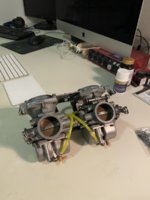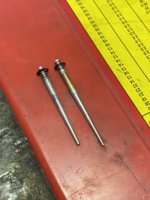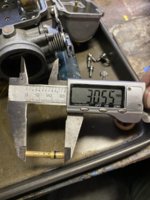OfflineForever
XS650 Member
So I bought my first bike.... definitely a parts bike from what I can tell, the US (which is weird in Australia).
Rode around on it for about a week but was having trouble with hesitation, plug fouling etc. Found air leaks around the intake boots so I decided to buy new boots, gaskets and rebuild kits from geoff's XS.
Motor: 447-205XXX (1976 XS650C)
Carbs: BS38CV (dual throttle, linked at top of carbs… early 70s?)
Pipes: Straight pipes w/small baffle inserts
New intake boots and gaskets.
New spark plugs (BP7ES).
Checked cam chain tension, valves, points and timing (all in spec)
Float bowl set to 25mm.
Previous pilot jets: #45
Previous main jets: #130
Current pilot jets: #27.5
Current main jets: #135
So after rebuilding my carbs with geoff’s XS kits, they are still running poorly.
I replaced and cleaned everything I could and triple checked everything.
I believe I have concluded that my jetting is way off now, due to the disparity of different BS38 models etc, I didn't check my original jets before ordering either...
Even if I set my mix screw all the way in, it will blow black smoke when rev’ed.
I also noticed fuel comes up around the needle jet, which from my understanding, would create a rich mixture. I will purchase new and replace.
What I’m trying to understand is, if my pilot jets are smaller than before, why are my symptoms SO much richer?
Is it because the air leaks were creating this somewhat balanced mix haha?
I attempted a ride after rebuilding and it felt SO sluggish and bogged. It actually stalled too.
Do I return to the previous jetting or is there another combo I should really look at?
While I'm at it, can anyone confirm the needle jet I need for these carbs?
From what I can tell, a Z6 Long?
Any help is much appreciated!
Rode around on it for about a week but was having trouble with hesitation, plug fouling etc. Found air leaks around the intake boots so I decided to buy new boots, gaskets and rebuild kits from geoff's XS.
Motor: 447-205XXX (1976 XS650C)
Carbs: BS38CV (dual throttle, linked at top of carbs… early 70s?)
Pipes: Straight pipes w/small baffle inserts
New intake boots and gaskets.
New spark plugs (BP7ES).
Checked cam chain tension, valves, points and timing (all in spec)
Float bowl set to 25mm.
Previous pilot jets: #45
Previous main jets: #130
Current pilot jets: #27.5
Current main jets: #135
So after rebuilding my carbs with geoff’s XS kits, they are still running poorly.
I replaced and cleaned everything I could and triple checked everything.
I believe I have concluded that my jetting is way off now, due to the disparity of different BS38 models etc, I didn't check my original jets before ordering either...
Even if I set my mix screw all the way in, it will blow black smoke when rev’ed.
I also noticed fuel comes up around the needle jet, which from my understanding, would create a rich mixture. I will purchase new and replace.
What I’m trying to understand is, if my pilot jets are smaller than before, why are my symptoms SO much richer?
Is it because the air leaks were creating this somewhat balanced mix haha?
I attempted a ride after rebuilding and it felt SO sluggish and bogged. It actually stalled too.
Do I return to the previous jetting or is there another combo I should really look at?
While I'm at it, can anyone confirm the needle jet I need for these carbs?
From what I can tell, a Z6 Long?
Any help is much appreciated!




 ) came with the stock 1976 carbs and it ran well but after a while, one of the float needles started to leak (which is a PITA) and so I ordered the parts to fix both of them - but at almost the same time, a pair of 1978 carbs appeared for sale on the Forum - for a very low price. The advert stated that the carbs had been mounted on a 1975 bike (remember that fact) but that the bike ran poorly and the carbs were thus, for sale and so on an an impulse, I bought them.
) came with the stock 1976 carbs and it ran well but after a while, one of the float needles started to leak (which is a PITA) and so I ordered the parts to fix both of them - but at almost the same time, a pair of 1978 carbs appeared for sale on the Forum - for a very low price. The advert stated that the carbs had been mounted on a 1975 bike (remember that fact) but that the bike ran poorly and the carbs were thus, for sale and so on an an impulse, I bought them.